
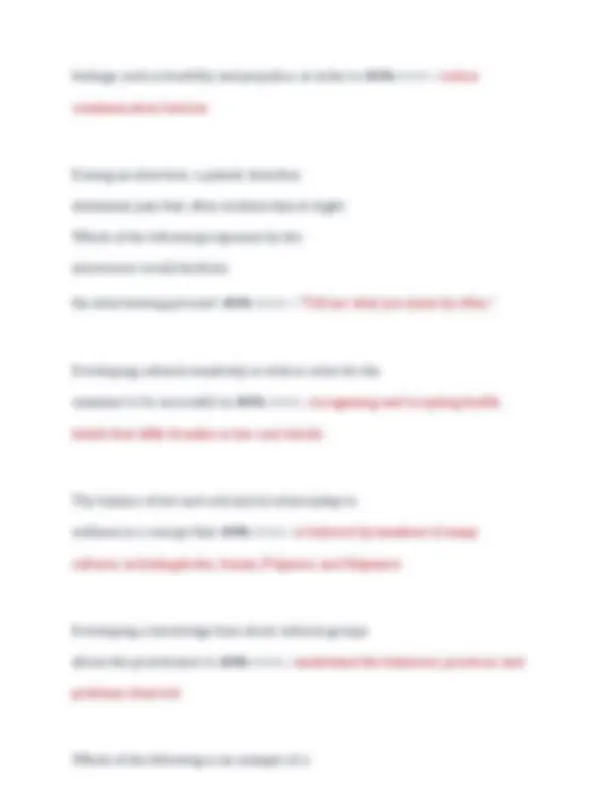
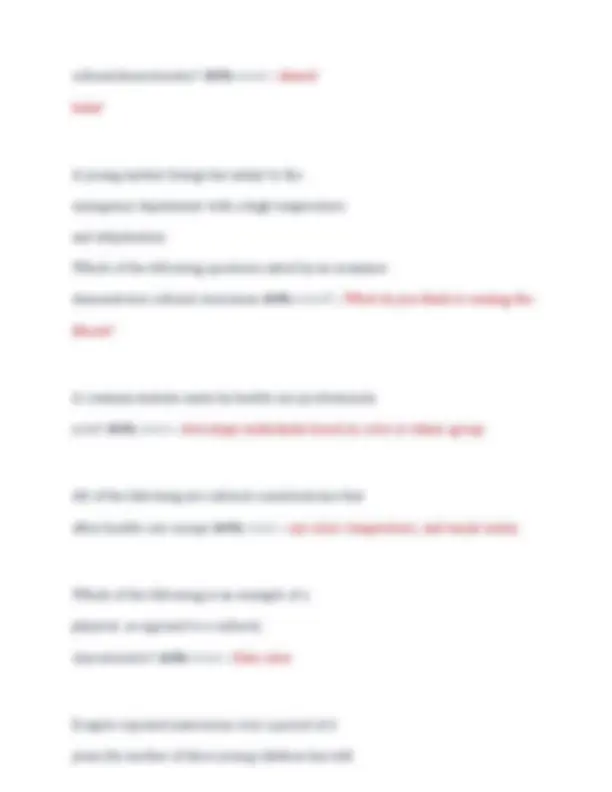
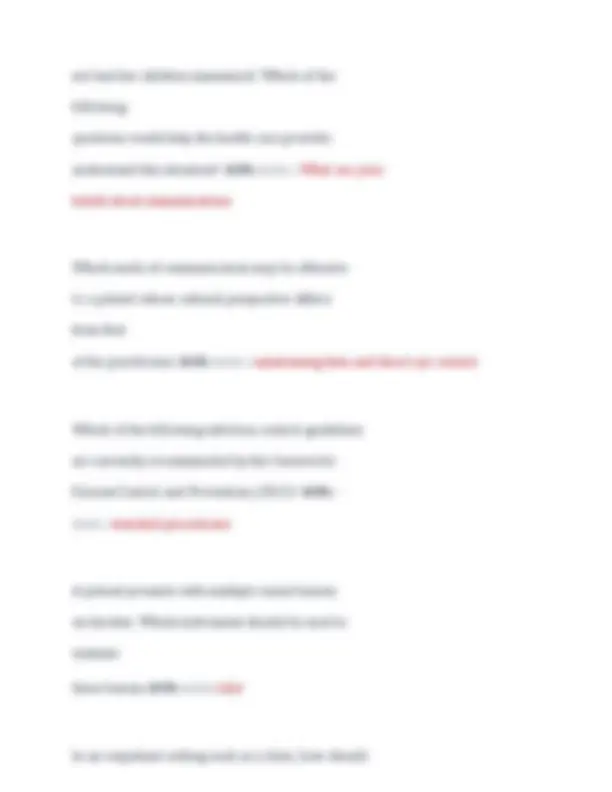
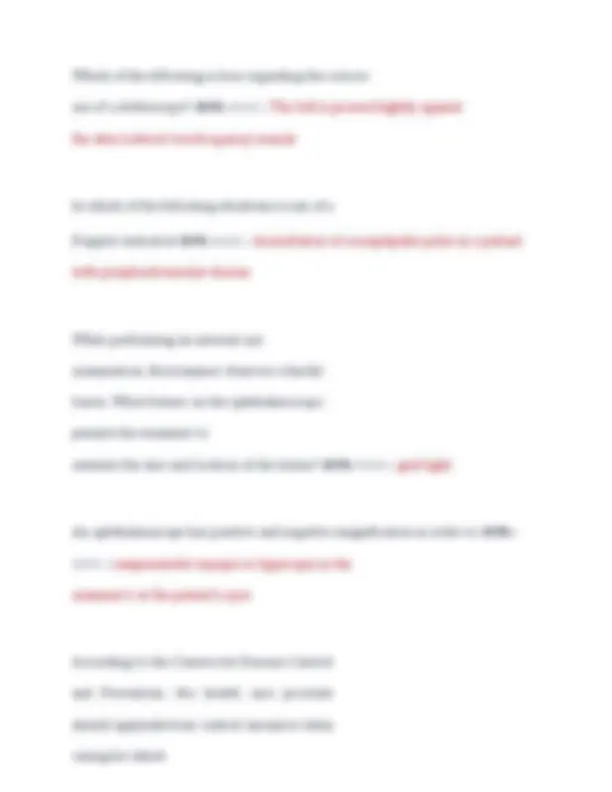
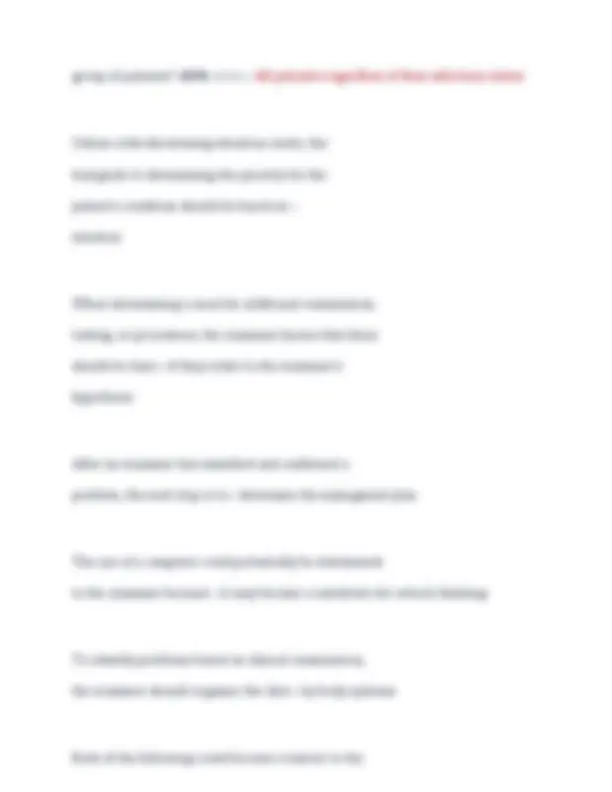
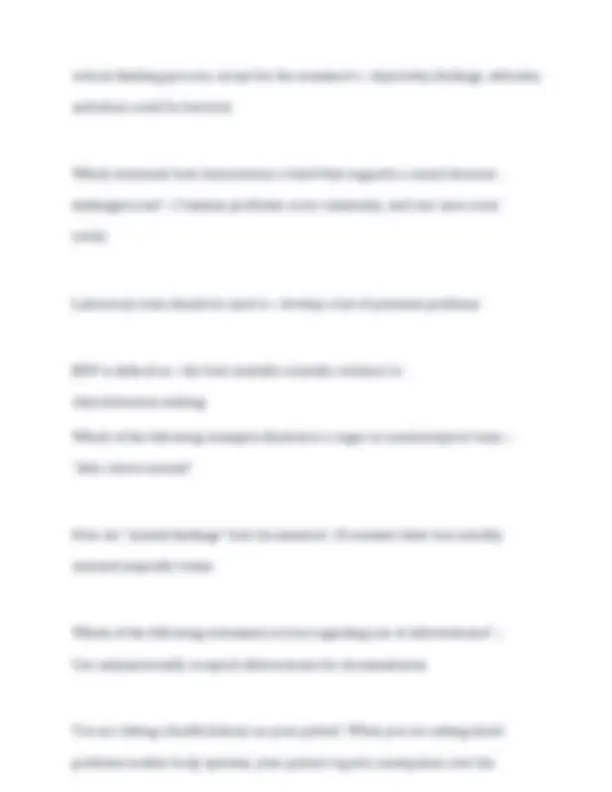
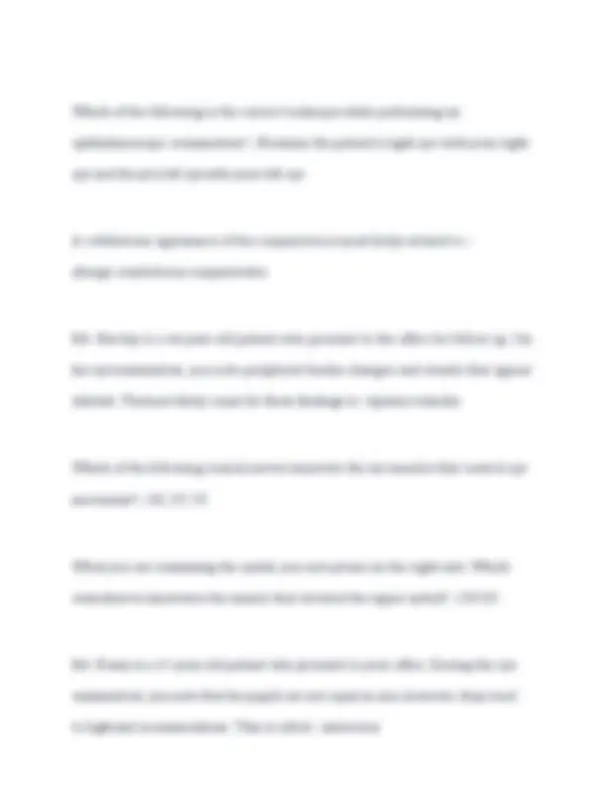
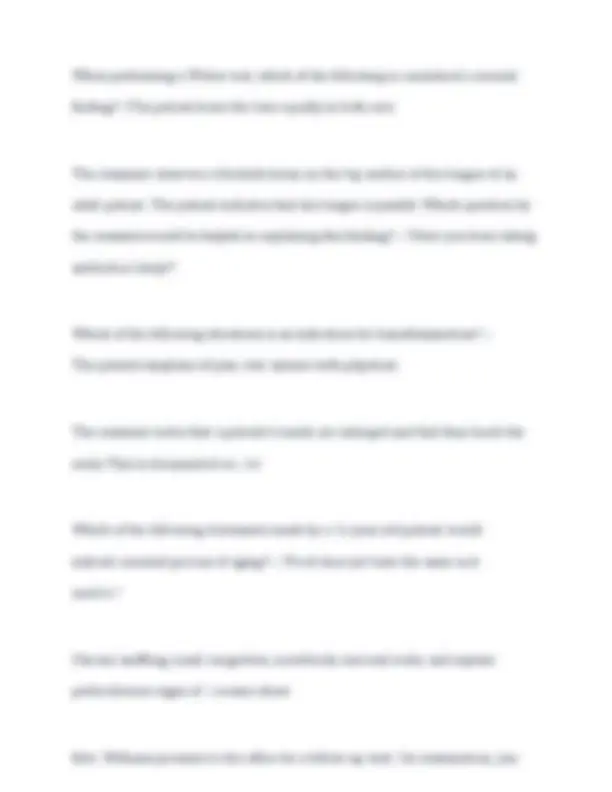
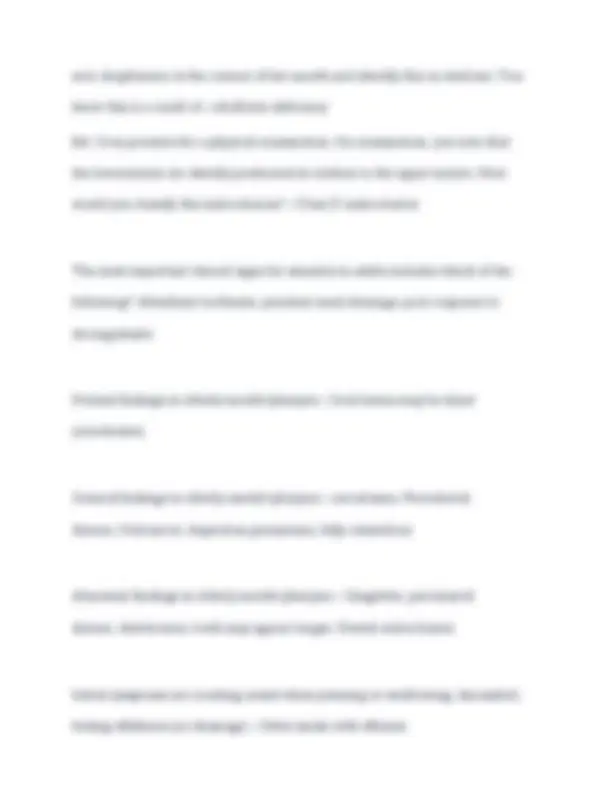
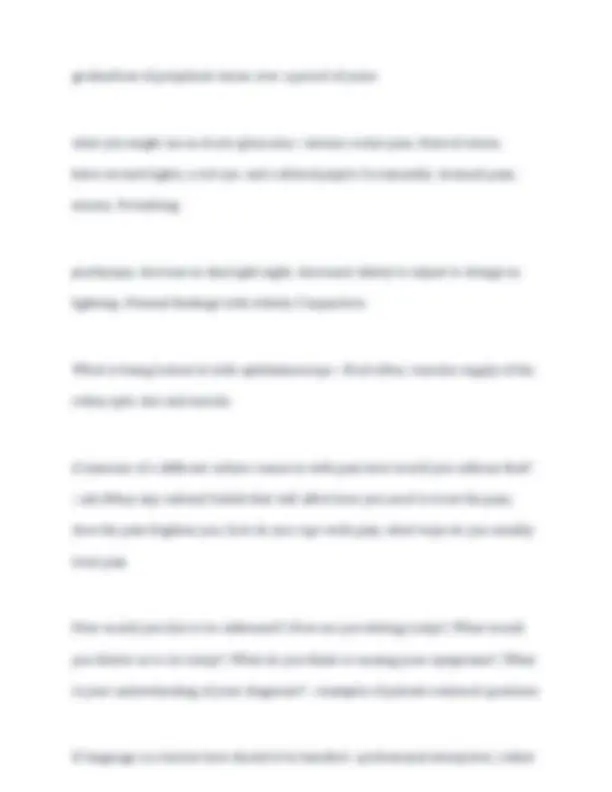
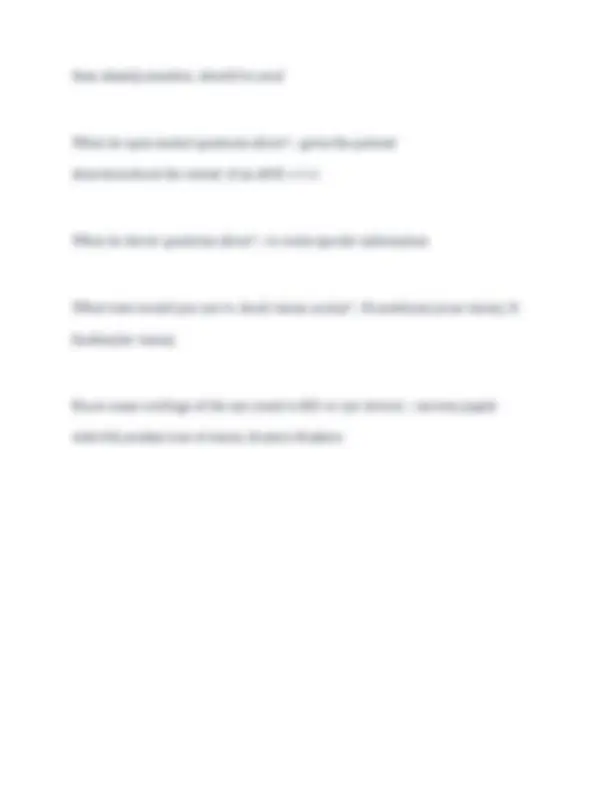
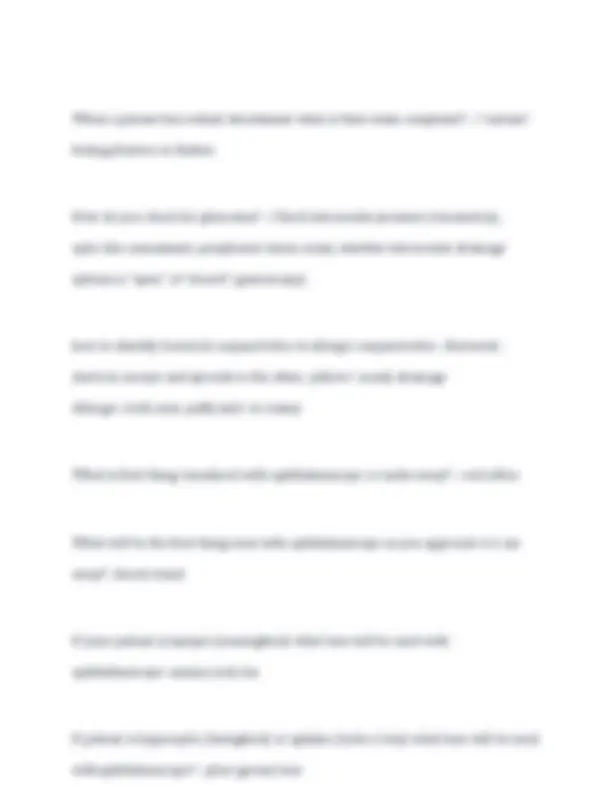
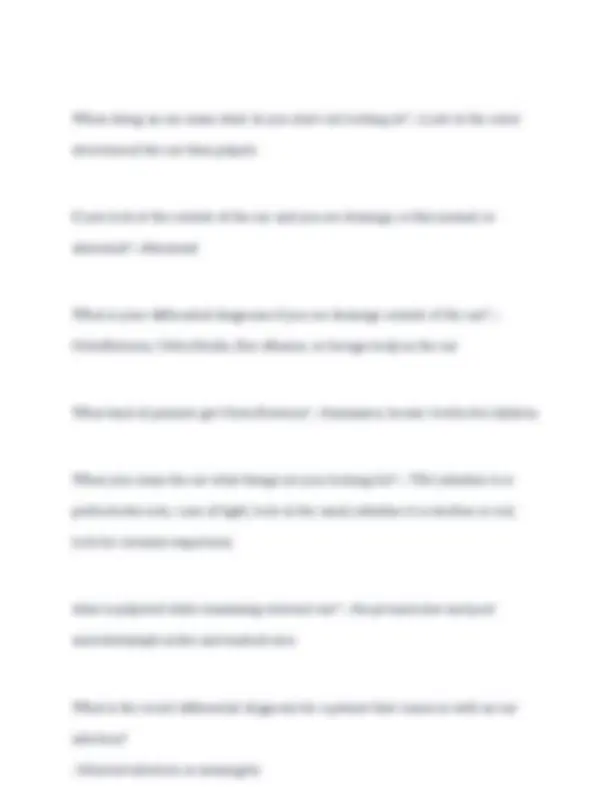

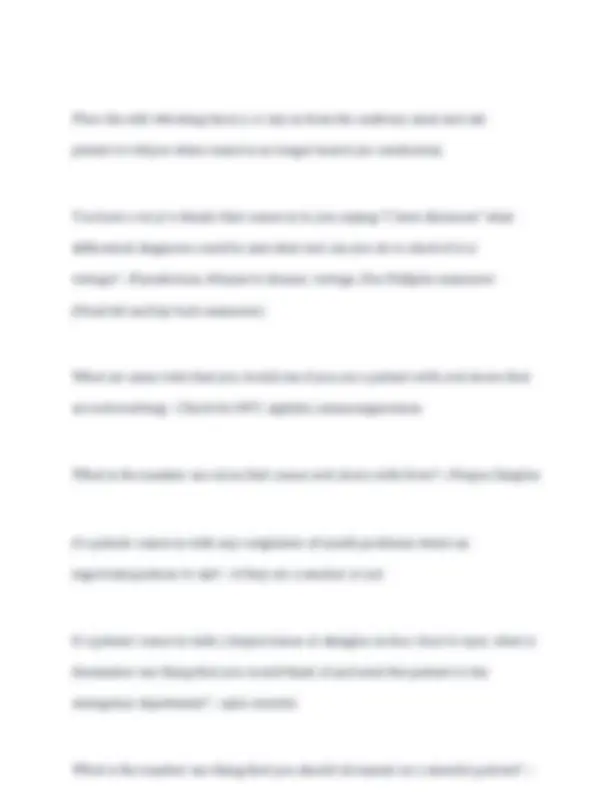
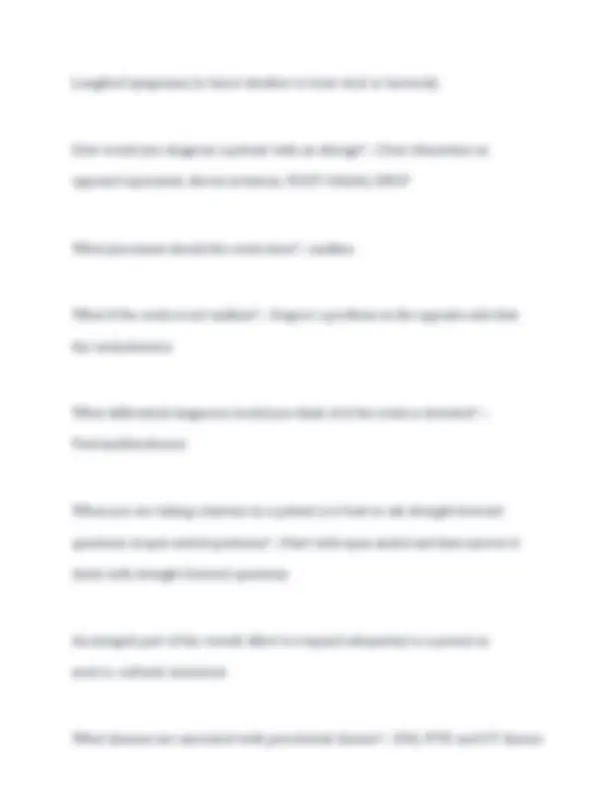
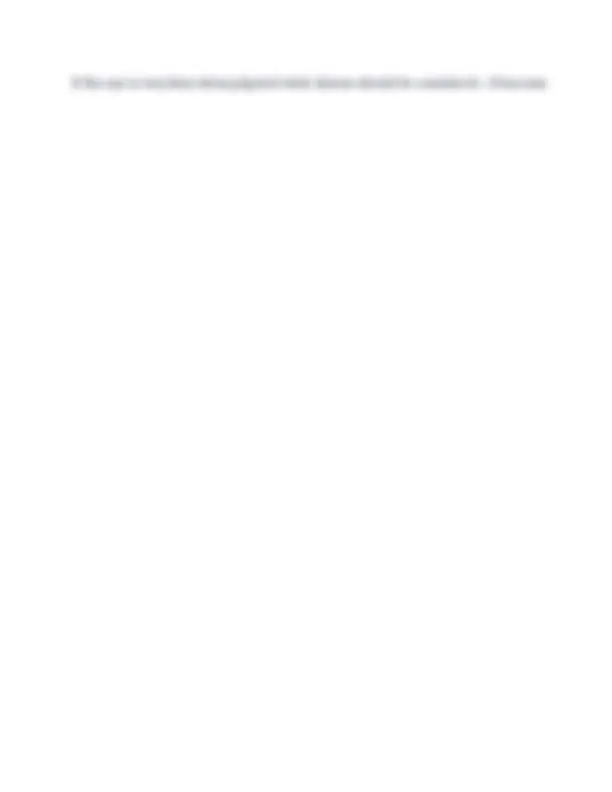
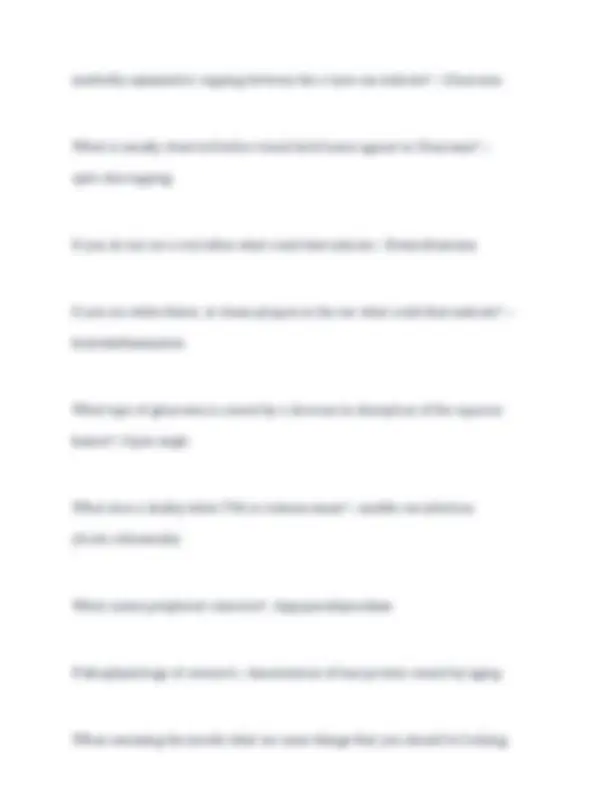
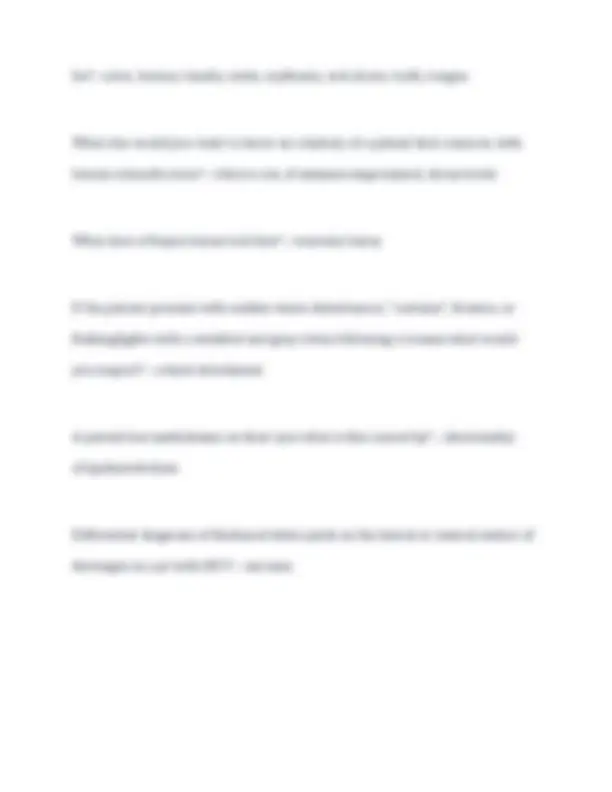


Study with the several resources on Docsity

Earn points by helping other students or get them with a premium plan


Prepare for your exams
Study with the several resources on Docsity

Earn points to download
Earn points by helping other students or get them with a premium plan
Community
Ask the community for help and clear up your study doubts
Discover the best universities in your country according to Docsity users
Free resources
Download our free guides on studying techniques, anxiety management strategies, and thesis advice from Docsity tutors
A comprehensive set of questions and answers covering key aspects of patient interviewing and physical examination techniques in nursing. it covers topics such as effective communication with diverse patients, cultural sensitivity in healthcare, infection control, and the proper use of examination instruments. The q&a format is ideal for self-assessment and exam preparation.
Typology: Exams
1 / 27

This page cannot be seen from the preview
Don't miss anything!




















Which of the following will best facilitate the interview when obtaining a history for a deaf patient who can read lips? ANS:->>> - speaking slowly During a history, the patient indicates he has an uncle and a brother with sickle cell disease. Which of the following is an appropriate method to document this information? ANS:->>> - Include it in the family history. Which approach is recommended at the onset of an interview ANS:->>>? - Use an open-ended approach; let the patient explain the problem or reason for the visit. Which of the following questions may lead to an inaccurate patient response? ANS:->>> - "That was a horrible experience, wasn't it?" Repeating a patient's ANS:->>> is an attempt to ANS:->>> - confirm an accurate
understanding. During an interview, your patient admits to feeling worthless and having a sleep disturbance for the past 3 weeks. These are clues that warrant the exploration of ANS:->>> - risk for suicide Jerry, a 26-year-old homosexual man, is having a health history taken. Which question regarding sexual activity would most likely hamper trust between Jerry and the interviewer? ANS:->>> - Are you married or do you have a girlfriend When questioning a patient regarding a sensitive issue, such as drug use, it is best to ANS:->>> - be direct, firm, and to the point Direct questions are designed to ANS:->>> - obtain or clarify specific details about an ANS:->>> Interviewers should identify and assess their own
cultural characteristic? ANS:->>> - shared belief A young mother brings her infant to the emergency department with a high temperature and dehydration. Which of the following questions asked by an examiner demonstrates cultural awareness ANS:->>>? - What do you think is causing the illness? A common mistake made by health care professionals is to? ANS:->>> - stereotype individuals based on color or ethnic group All of the following are cultural considerations that affect health care except ANS:->>> - eye color, temperature, and visual acuity Which of the following is an example of a physical, as opposed to a cultural, characteristic? ANS:->>> - Skin color Despite repeated instruction over a period of 3 years, the mother of three young children has still
not had her children immunized. Which of the following questions would help the health care provider understand this situation? ANS:->>> - What are your beliefs about immunizations Which mode of communication may be offensive to a patient whose cultural perspective differs from that of the practitioner ANS:->>> - maintaining firm and direct eye contact Which of the following infection control guidelines are currently recommended by the Centers for Disease Control and Prevention (CDC)? **ANS:-
** - standard precautions A patient presents with multiple raised lesions ** - shared belief A young mother brings her infant to the emergency department with a high temperature and dehydration. Which of the following questions asked by an examiner demonstrates cultural awareness ANS:->>>? - What do you think is causing the illness? A common mistake made by health care professionals is to? ANS:->>> - stereotype individuals based on color or ethnic group All of the following are cultural considerations that affect health care except ANS:->>> - eye color, temperature, and visual acuity Which of the following is an example of a physical, as opposed to a cultural, characteristic? ANS:->>> - Skin color Despite repeated instruction over a period of 3 years, the mother of three young children has still not had her children immunized. Which of the following questions would help the health care provider understand this situation? ANS:->>> - What are your beliefs about immunizations Which mode of communication may be offensive to a patient whose cultural perspective differs from that of the practitioner ANS:->>> - maintaining firm and direct eye contact Which of the following infection control guidelines are currently recommended by the Centers for Disease Control and Prevention (CDC)? ANS:- >>> - standard precautions A patient presents with multiple raised lesions on her skin. Which instrument should be used to examine these lesions ANS:->>> ruler In an outpatient setting such as a clinic, how should
As a component of palpation, which surface is most sensitive to vibration ANS:->>> - ulnar surface of the hand How deep should the examiner's hands press while performing deep palpation? ANS:->>> - 4 cm The term intensity, when used in relation to percussion tones, refers to - the loudness of the tone. The examiner has detected a superficial mass in the skin. What part of the hand is best to use to palpate this mass? ANS:->>> - fingertips Ideally, auscultation should be carried out last, except when examining the ANS:->>> - abdomen Which of the following techniques is incorrect and affects the accuracy of auscultation? - Auscultating through clothing
Which of the following is true regarding the correct use of a stethoscope? ANS:->>> - The bell is pressed lightly against the skin todetect low-frequency sounds In which of the following situations is use of a Doppler indicated ANS:->>> - Auscultation of a nonpalpable pulse in a patient with peripheral vascular disease While performing an internal eye examination, theexaminer observes a fundal lesion. What feature on the ophthalmoscope permits the examiner to estimate the size and location of the lesion? ANS:->>> - grid light An ophthalmoscope has positive and negative magnification in order to **ANS:-
** - compensate for myopia or hyperopia in the examiner's or the patient's eyes. According to the Centers for Disease Control and Prevention, the health care provider should apply infection control measures when caring for which
critical thinking process, except for the examiner's - objectivity (feelings, attitudes, and values could be barriers) Which statement best characterizes a belief that supports a sound decision- making process? - Common problems occur commonly, and rare ones occur rarely Laboratory tests should be used to - develop a list of potential problems EBP is defined as - the best available scientific evidence to clinicaldecision making. Which of the following examples illustrates a vague or nondescriptive term - "skin color is normal" How are "normal findings" best documented - Document what was actually assessed in specific terms. Which of the following statements is true regarding use of abbreviations? - Use only universally accepted abbreviations for documentation You are taking a health history on your patient. When you are asking about problems in other body systems, your patient reports constipation over the
past 5 or 6 months. This would be documented in - Review of symptoms Your patient presents to the office with a chief complaint of shoulder pain that he reports as stabbing. In using the mnemonic OLDCARTS, this is noted as - characteristic Before instilling a mydriatic eyedrop, the examiner should - observe the eye with focused light tangentially The examiner screens a 5-year-old child for nystagmus by - inspecting movement of theeyes to the six cardinal fields of gaze Which of the following correctly describes the method to assess accommodation? - Constriction should be noted as gaze shifts from across the room to an object 6 inches away. Which of the following should be used to test for near vision? - Rosenbaum chart To visualize the macula, the examiner should ask the patient to - look directly into the light of the ophthalmoscope. A 51-year-old patient tells the examiner, "My mother had glaucoma. What can I
Which of the following is the correct technique while performing an ophthalmoscopic examination? - Examine the patient's right eye with your right eye and the pt's left eye with your left eye A cobblestone appearance of the conjunctiva is most likely related to - allergic or infectious conjunctivitis Mr. Barclay is a 48-year-old patient who presents to the office for follow up. On his eye examination, you note peripheral fundus changes and vessels that appear whitish. The most likely cause for these findings is - lipemia retinalis Which of the following cranial nerves innervate the six muscles that control eye movement? - III, IV, VI When you are examining the eyelid, you note ptosis on the right side. Which cranial nerve innervates the muscle that elevated the upper eyelid? - CN III Mr. Kasey is a 57-year-old patient who presents to your office. During the eye examination, you note that his pupils are not equal in size; however, they react to light and accommodation. This is called - anisocoria
When performing a Weber test, which of the following is considered a normal finding? - The patient hears the tone equally in both ears. The examiner observes a blackish lesion on the top surface of the tongue of an adult patient. The patient indicates that his tongue is painful. Which question by the examiner would be helpful in explaining this finding? - "Have you been taking antibiotics lately?" Which of the following situations is an indication for transillumination? - The patient complains of pain over sinuses with palpation. The examiner notes that a patient's tonsils are enlarged and that they touch the uvula. This is documented as - 3+ Which of the following statements made by a 72-year-old patient would indicate a normal process of aging? - "Food does not taste the same as it used to." Chronic sniffling, nasal congestion, nosebleeds, mucosal scabs, and septum perforation are signs of - cocaine abuse Mrs. Williams presents to the office for a follow-up visit. On examination, you
Exam shows conductive loss as ears fills with fluid, retracted or bulging TM, impaired mobility, yellowish air-fluid level and bubbles - Otitis media with effusion Initial symptoms of Abrupt onset, fever, feels blocked, anorexia, irritability, deep-seated ear ache, if TM ruptured foul-smelling discharge - Acute Otitis Media Exam shows conductive loss as ears fills with pus, TM with distinct erythema, thickened or clouding; bulging, impaired mobility, air-fluid level and bubbles - Acute Otitis Media Exam shows Meatus inflamed, tender and weeping, extreme pain, nothing can be seen of interior canal. - Otitis Externa (Swimmer's ear) What tests are done to test hearing? - Whisper, Weber, & Rinne expected findings of Weber test - sound heard equally in both ears expected findings for the Rinne test - air conduction (AC) greater than bone conduction (BC); 2:1 ration
Abnormal findings with elderly Conjunctiva - Cataracts Age related macular degeneration Diabetic retinopathy Glaucoma What is disease that progressively destroys the macula, impairing central vision - Age related macular degeneration (AMD): gradual blurring of central vision, and increased difficulty reading fine print, recognizing faces or seeing street signs - Dry AMD progression... rapid loss of central vision, with metamorphopsia (images that appear distorted
than afamily member, should be used What do open-ended questions allow? - gives the patient discretion about the extent of an ANS:->>> What do direct questions allow? - to seeks specific information What tests would you use to check vision acuity? - Rosenbaum (near vision) & Snellen(far vision) Know some red flags of the eye (send to ED or eye doctor) - uneven pupils with HA,sudden loss of vision, floaters/flashers
When a patient has retinal detachment what is their main complaint? - "curtain" feeling, floaters or flashes How do you check for glaucoma? - Check intraocular pressure (tonometry); optic disc assessment, peripherial vision exam, whether intraocular drainage system is "open" or "closed" (gonioscopy) how to identify bacterial conjunctivitis vs allergic conjunctivitis - Bacterial- starts in one eye and spreads to the other, yellow/ crusty drainage Allergic- both eyes, puffy and/ or runny What is first thing visualized with ophthalmascope 12 inchs away? - red reflex What will be the first thing seen with ophthalmascope as you approach 3-5 cm away? - blood vessel If your patient is myopic (nearsighted) what lens will be used with ophthalmascope - minus (red) len If patient is hyperoptic (farsighted) or aphakic (lacks a lens) what lens will be used with ophthalmascope? - plus (green) lens